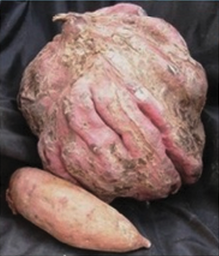Sweet potatoes need not be merely for Thanksgiving dinner — Dr. Janice Bohac is developing varieties that can produce more than four times more ethanol per acre than corn
Acres U.S.A. What’s your background — how did you get interested in sweet potatoes?
Janice Bohac. I have a Ph.D. in plant breeding and genetics, and I was a sweet potato breeder for the USDA Agricultural Research Service for about 20 years.
Sweet potato had a lot of potential back in the old days. My predecessor was working on sweet potatoes for gasohol, so I decided to take early retirement and bought my own research farm, and I’ve continued to work in this area.
Most people don’t realize that sweet potato is the sixth largest crop in the world, but 90 percent of the world’s sweet potatoes are grown in Asia, and 90 percent of those are grown in China.
Acres U.S.A. And this is sweet potatoes proper, not yams.

Bohac. Correct. Yams are Dioscorea — a different genus altogether, not related to sweet potato.
I think of sweet potato as being parallel with corn. You’ve got your vegetable sweet corn, which is handled very carefully and is expensive to grow but is very profitable. And then you’ve got all the other kinds of corn, particularly field corn, that go into a lot of industrial uses — fuel ethanol of course being one of them. Sweet potatoes are used this way in China. There are varieties to eat, but they also have other varieties that they extract the starch from and use for making paper, coatings, munitions and all kind of industrial uses. It’s like how we use corn starch.
So, there are a lot of uses for sweet potatoes. Its biggest selling point is that it can yield a whole lot more than corn per acre — four-and-a-half or five times as much starch per acre as corn. It’s an indeterminate crop, which means the longer you grow it, the bigger it gets. And it doesn’t waste a lot of energy. With a corn plant, you grow stalks and stems and a cob, and the only part you really want are the kernels. Same thing with soybeans — the only part you want is the oil that’s in the seed.
Whereas sweet potatoes are kind of like a solar panel. You’ve got a big leaf, like a solar panel, and you’ve got a vine — think of that like a cable. The cable goes down underground to the potato, which is where it’s storing all its energy. It doesn’t waste a lot of energy making a lot of structure.
It’s a crop that needs a long growing season, but it grows in poor soils. One of the big things I worked on at USDA was breeding for insect resistance and nematode resistance, and we have varieties with excellent resistance to 14 insects and root-knot nematodes. We have allelopathy in some of the lines for weeds. So, we have a lot of interesting traits.
Acres U.S.A. We grow sweet potatoes here in southern Michigan, and the yield is incredible, and they don’t seem to have much pest pressure. But we’re not maximizing yield like you could do in the South. And deer love them.
Support authors and subscribe to content
This is premium stuff. Subscribe to read the entire article.



















